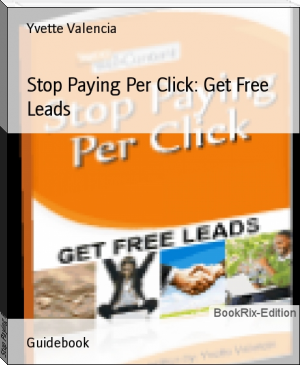Stop Paying Per Click: Get Free Leads by Yvette Valencia (best summer books TXT) 📖

- Author: Yvette Valencia
Book online «Stop Paying Per Click: Get Free Leads by Yvette Valencia (best summer books TXT) 📖». Author Yvette Valencia
Stop Paying Per Click!
Learn How to Get
Free Internet Leads
2nd Edition
Table of Contents
Pay-Per-Click Advertising 4
Advantages of PPC 4
Disadvantages of PPC 4
Banner Advertisements 5
Google AdWords 5
Yahoo Sponsored Results 5
Search Engine Optimization 6
Content, Content & More Content 6
Your Website’s PageRank 6
Your Target Audience 7
Link Exchange 8
Search Engines and Links 8
Types of Link Exchanges 8
Getting Started 9
Social Networking Websites 11
Facebook 11
Twitter 12
What Makes a Successful Profile 12
Resources Required 13
Online Business Listings 14
What is an Online Business Listing? 14
Register Your Business 14
Online Referral Directories 16
How to Get Started 16
Cost and Time 16
Your Online Presence 17
Generate Exposure 17
Blog with a Purpose 18
Present Content with Style 19
What is Your Goal? 20
Generate Leads 20
Drive a Political Issue or Cause 21
Serve Your Existing Customers 22
How To Develop Content 23
Do You Have Time To Write? 23
Retaining a Content Strategy Firm 23
We Do Web Content’s Services 24
As more and more people turn to the Internet for both their personal and professional lives, businesses are increasing their online presence. Recently there has been a shift away from business owners and marketing directors using standard advertising methods such as banner ads and paid placement ads. The Web is still evolving, and new portals have been created that present creative marketing opportunities and advertising.
While considering how much money to spend on online endeavors can be daunting for a business owner or marketing director, there are a number of alternatives to Pay-Per-Click advertising that you can explore. Many of these options are free or low-cost, such as online local business listings with major search engines. Other options, like ensuring your content on the Web is search engine optimized, offers long-term benefits like increased page ranking, as well as interesting material for your visitors to read.
We Do Web Content specializes in online marketing campaigns and incorporates many of the methods discussed in the following chapters to build or expand a client’s presence on the Web. We are confident that this book will be a valuable resource for you as you consider different ways to attract and maintain customers beyond the world of Pay-Per-Click.
Pay-Per-Click Advertising
Pay-Per-Click is an advertising model used by search engines and content sites in which advertisers only pay a host when their ad is clicked on by a user. Businesses typically pay the host a flat-fee or bid per click.
Pay Per Click (PPC) includes:
• Placement of ads with a PPC provider such as Google AdWords, Yahoo! Search Marketing or Microsoft adCenter.
• Payment to a host per click.
• Safeguards against possible abuse of clicks by competitors and Web developers.
While PPC can drive traffic to a site, it can also be costly compared to hiring a firm to develop well-written content for your website. The purpose of adding content to your site is to increase your page rankings and visitors. There is much controversy over pay-per-click advertising; the following are some pros and cons associated with PPC:
Advantages of PPC
• Payment is due only if someone clicks on your ad.
• Control the amount you spend by setting a limit on the amount of money you dedicate to PPC.
• PPC is easy to set up.
• Target advertisement according to time of day, location, etc.
• Track conversions and analyze your website’s traffic.
Disadvantages of PPC
• PPC can be costly – as much as $1 or more per click.
• You can easily be outbid and lose your competitive edge.
• You need to regularly review your campaign to exclude keywords that are not effectively driving traffic to your site.
• Fraud accounts for over 28% of all clicks on Google AdSense and Yahoo Publisher.
• PPC cannot improve a site’s page ranking with the search engines.
Banner Advertisements
A banner advertisement, or “Web banner,” is a graphic used on a website to advertise a product or service. Banners often appear at the top of a Web page, or in the left or right margin of the page. Users are encouraged to click through to the advertiser’s website. Click-through rates are now estimated at less than 1%.
As businesses look for creative ways to increase the click through rate for banner ads, animation and sound have been added to make the advertisements more seductive.
Google AdWords
Google AdWords is the Google-sponsored pay-per-click advertising option that allows users to create ads and choose keywords and phrases that are related to your business. When people search on Google using your keywords, your ad may appear next to the search results.
Yahoo Sponsored Results
Yahoo Sponsored Results are paid listings that appear on Yahoo Search results pages. Sponsored Results are another pay-per-click model in which businesses bid for enhanced placement in search results using terms that are relevant to their business.
Search Engine Optimization
Search Engine Optimization (SEO) is the process of writing behind-the-scenes code that will improve the number and quality of visitors (traffic) to your website from search engines through search results.
When you initiate a search on the Internet, typically you compose a keyword, tag or “long tail” keyword that summarizes what you are looking for. This is also referred to as an “organic search”. Some popular search engines are Google, Yahoo, and Bing.
Example of an organic search:
A Web user wants to find a company that sells Granny Smith apples in bulk. They might search with a:
• Keyword or tag = “bulk apples”; or
• Long-tail keyword = “company that sells Granny Smith apples in bulk”.
After submitting this query to the search engine, results appear and the Web user can select the site(s) that interests them.
Content, Content & More Content
The more relevant and keyword-dense your Web content is, the more likely it is that your website will be found by the search engines and by the humans that use them.
Working with a company that understands the importance of search engine optimization and its relationship to Web content is vital in getting the most return on the time, money, and other resources you invest in your website.
Your Website’s PageRank
It used to be that one of the primary goals of SEO copywriting was to achieve a high Google PageRank. A PageRank, which is mainly based on the number of high ranking websites that are linking to a particular Web page (referred to as inbound links or backlinks), determines where a Web page will be indexed in a search result. The theory being that if several high ranking websites are linking to a Web page, then it must be relevant to a particular keyword or set of keywords and must be given one of the top 10 spots on the first page.
Is a high PageRank really that important?
Well, in our experience, PageRank is not as important as it used to be. There are other factors that are now taking the front seat when evaluating the value and relevancy of a Web page, such as the keyword density in your content, page titles, and even your URL.
Often we will see websites with lower PageRanks outperform those with higher ones. Why? In most cases, it’s because the lower ranking websites are posting relevant and keyword-rich content on a frequent basis.
So, are we saying that you shouldn’t devote any time to exchanging and acquiring links? No. In fact, we have dedicated a section of this book to link building. What we are saying, however, is this – your time would be better spent developing your website’s content. One, because you need to keep your website’s content fresh and two, because good content will provoke others to link to you thereby increasing your PageRank naturally.
Your Target Audience
We cannot say this enough – the content on your website must be relevant, engaging, and informative in order to attract and retain customers. Most importantly, it must motivate your reader to take action.
That action could be:
• Telephoning your business;
• Ordering a product through your website; or
• Visiting other sections of the website.
Unlike shopping in person where the owner can greet customers as they walk in and help them find what they are looking for, website owners are at a slight disadvantage in that they have to work twice as hard to gain a Web user’s trust to build credibility.
Building a website that offers relevant and interesting information helps develop credibility and establish your customer base.
Link Exchange
Incorporating quality inbound and outbound links is an important component of your online marketing plan. Link exchange programs can help you gain exposure in the marketplace, increase your website’s PageRank, and build credibility with your visitors.
When paired with keyword-dense content, links can give your website the boost it needs to be listed on Page 1 of the search results.
Search Engines and Links
A variety of components are utilized by search engines when indexing websites. Software robots, or “spiders,” search the Web to index sites when a user conducts a key word/phrase search. The spiders look at variables including popularity of a site, age of a site, age of documents, keywords, and rate of new pages added to the site. Outbound and Inbound links (IBL) are weighted heavily during the ranking process.
Quality inbound links (or links from other websites to your website) allow the spiders to find your website faster, so you can be found by your customers easily.
The use of outbound and inbound links is a major factor in how Google’s algorithm ranks a webpage. Pages that provide valuable content and link to credible sources tend to have a higher page ranking than a website with similar content and no links.
Types of Link Exchanges
There are three different opportunities for a link exchange:
• Reciprocal link exchange;
• Non-reciprocal link exchange; and
• Indirect non-reciprocal link exchange.
A reciprocal link exchange occurs when your site provides a link to another site, and that site in turn provides a link to your site. This type of exchange may have been deliberate, or may occur due to the popularity or relevance of the two sites, For example, CNN links to the White House website and the White House site links to CNN.
A non-reciprocal link exchange occurs when a website provides a link to another site. This is a “one-way” link and the most beneficial type of link exchange for your site. Having a large number of sites that are linking back to your website validates its credibility amongst the search engines.
An indirect non-reciprocal link exchange involves three or more websites that link to each other. The goal is to create the illusion of natural links as the search engines may detect artificial links. A common scenario for an indirect non-reciprocal link exchange would be website A links to website B which links to website C, which links to website A.
Getting Started
Now that you understand the basics of SEO and the importance of a link exchange, how do you get started?
First, identify other websites that are relevant to your business’s objectives and customer base. It is important to note, providing links to sites that have irrelevant content can actually decrease your page rankings so it is vital to use discretion in linking.
When





Comments (0)